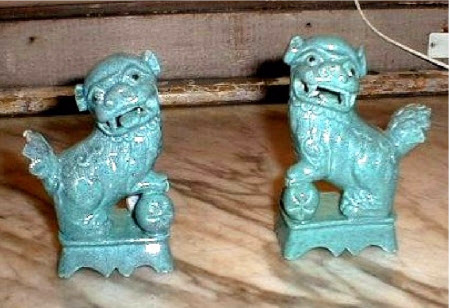Figure
Category
Ceramics
Date
c. 1723 - 1800
Materials
Porcelain, manganese, copper oxide, cobalt
Measurements
120 x 40 mm
Place of origin
Jingdezhen
Order this imageCollection
Belton House, Lincolnshire
NT 433509
Summary
Pair of figures of Buddhist lions, porcelain, depicted seated on their hind legs, looking to the side, with a ball under one of their front paws, on plinths with lobed and pointed aprons, made at Jingdezhen, Jiangxi Province, China, 18th century, covered with a mottled blue ‘robin’s egg’ glaze.
Full description
The fantastical appearance of these figures is partly explained by the fact that Chinese artisans would not have known real lions. The pedestals are an echo of the practice of placing large lion figures as guardians next to the entrances of temples. In the West, Buddhist lions are sometimes called ‘dogs of Fo’ or ‘dogs of Fu’, after the pronunciation of the character 佛 Fu, meaning ‘Buddha’ or ‘Buddhist’ in Mandarin. A similar Buddhist lion figure (with an additional tube on its back to hold an incense stick) is in the collection of the Victoria and Albert Museum, London, inv. no. 57–1883 (ex coll. Stephen Wootton Bushell [1844–1908]). ‘Robin’s egg’ blue glaze was developed in the Yongzheng period (1723-35). It involved applying a dark blue glaze first and then blowing a turquoise glaze on top of it (Krahl 1994). In Mandarin this glaze is known as 炉钧 lujun or ‘kiln Jun’ – i.e. inspired by the variegated glazes of the Jun wares of the Song (960–1279) and Ming (1368–1644) dynasties (Jingdezhen Institute of Ceramic Archaeology 2011).
References
Krahl 1994: Regina Krahl, Chinese Ceramics from the Meiyintang Collection, London, 1994 (vols. 1 and 2), vo. 2, no. 923 Jingdezhen Institute of Ceramic Archaeology 2011: Jingdezhen Institute of Ceramic Archaeology, The Cultures of Porcelain Superintendents and Jingdezhen, conference volume, Nanchang, 2011
